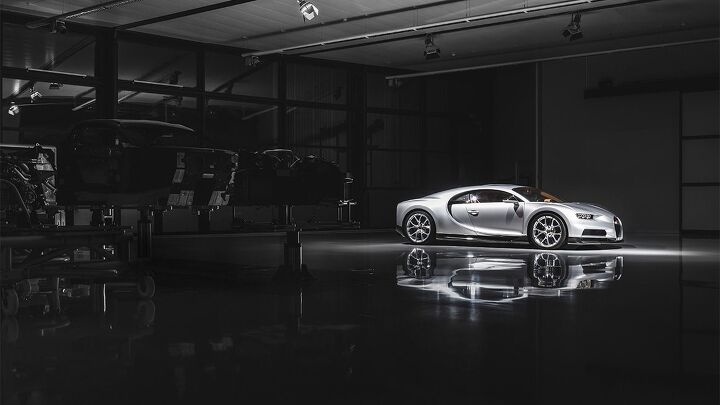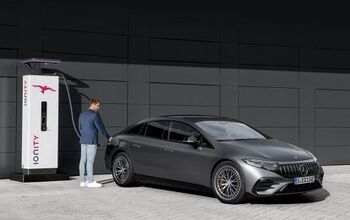2018 Bugatti Chiron Fuel Economy Figures Released: Not a Toyota Prius Rival Just Yet
The Bugatti Veyron EB 16.4 debuted in 2005 to spec sheet acclaim. On paper, there had never been anything like it. 16 cylinders, four turbos, 987 horsepower.
And 10 miles per gallon of premium gasoline.
The 2018 Bugatti Chiron is a better car, as it should be after more than a decade passed between development cycles. There are still 16 cylinders and four turbos, but Bugatti increased the power (having intermittently done so during the Veyron’s tenure) to 1,500 horses.
That 52 percent increase in power is not quite matched by a commensurate improvement in the distance travelled per gallon of premium gasoline. Not quite.
That said, the decision to add 513 horses — like adding to the Veyron the power of two Subaru Legacy six-cylinder powerplants — is not a decision that is expected to be associated with any fuel economy improvements. Nevertheless, time marches on, and the 2018 Bugatti Chiron will travel 10-percent farther on a gallon of gasoline than its Bugatti Veyron predecessor: 11 miles per gallon on the combined cycle.
In fact, the Chiron isn’t quite as efficient a highway traveller as some of the Veyron variants. The final five model years of the Veyron (2011-2015) were rated at 15 mpg highway. The Chiron drops to 14 mpg.
But because of the weighting the EPA testing procedure gives to city ratings — the Chiron is rated at 9 mpg city; Veyrons were 8-mpg cars — the 2018 Bugatti Chiron has the superior overall mpg rating. This is an important issue, a matter of grave consequence, as it speaks to the advances automakers make on the insides of engines and the outsides of cars to effectively reduce global emissions.
Granted, at top flight, a Chiron will empty its 26.4-gallon fuel tank in 12 minutes, so it may not be the darling of green car media. But if we could look forward to mainstream cars adding 50-percent more power and consuming 9-percent less fuel, all would be well with the world.
For the record, the Environmental Protection Agency says the Bugatti Chiron would annually cost $3,800 to fuel as a daily driver (8,250 city miles, 6,750 highway miles, $2.80/gallon) and $12,250 more to fuel than the average new vehicle over the course of five years.
[Images: Bugatti]
Timothy Cain is a contributing analyst at The Truth About Cars and Autofocus.ca and the founder and former editor of GoodCarBadCar.net. Follow on Twitter @timcaincars.
More by Timothy Cain
Latest Car Reviews
Read moreLatest Product Reviews
Read moreRecent Comments
- Groza George I don’t care about GM’s anything. They have not had anything of interest or of reasonable quality in a generation and now solely stay on business to provide UAW retirement while they slowly move production to Mexico.
- Arthur Dailey We have a lease coming due in October and no intention of buying the vehicle when the lease is up.Trying to decide on a replacement vehicle our preferences are the Maverick, Subaru Forester and Mazda CX-5 or CX-30.Unfortunately both the Maverick and Subaru are thin on the ground. Would prefer a Maverick with the hybrid, but the wife has 2 'must haves' those being heated seats and blind spot monitoring. That requires a factory order on the Maverick bringing Canadian price in the mid $40k range, and a delivery time of TBD. For the Subaru it looks like we would have to go up 2 trim levels to get those and that also puts it into the mid $40k range.Therefore are contemplating take another 2 or 3 year lease. Hoping that vehicle supply and prices stabilize and purchasing a hybrid or electric when that lease expires. By then we will both be retired, so that vehicle could be a 'forever car'. And an increased 'carbon tax' just kicked in this week in most of Canada. Prices are currently $1.72 per litre. Which according to my rough calculations is approximately $5.00 per gallon in US currency.Any recommendations would be welcomed.
- Eric Wait! They're moving? Mexico??!!
- GrumpyOldMan All modern road vehicles have tachometers in RPM X 1000. I've often wondered if that is a nanny-state regulation to prevent drivers from confusing it with the speedometer. If so, the Ford retro gauges would appear to be illegal.
- Theflyersfan Matthew...read my mind. Those old Probe digital gauges were the best 80s digital gauges out there! (Maybe the first C4 Corvettes would match it...and then the strange Subaru XT ones - OK, the 80s had some interesting digital clusters!) I understand the "why simulate real gauges instead of installing real ones?" argument and it makes sense. On the other hand, with the total onslaught of driver's aid and information now, these screens make sense as all of that info isn't crammed into a small digital cluster between the speedo and tach. If only automakers found a way to get over the fallen over Monolith stuck on the dash design motif. Ultra low effort there guys. And I would have loved to have seen a retro-Mustang, especially Fox body, have an engine that could rev out to 8,000 rpms! You'd likely be picking out metal fragments from pretty much everywhere all weekend long.



































Comments
Join the conversation
No one daily drives a Chiron or the Veyron before it. Even very rich people avoid driving them because of the costs per mile other than fuel. Such as the tires that cost $35,000 a set every 2,500 miles. The wheels need to be replaced at every 3rd tire change at $50,000! That's $155,000 in wheels and tires at just 10,000 miles.
F1 cars cost about 1,000 times the fuel cost to operate and their fuel isn't pump gas as we know it.